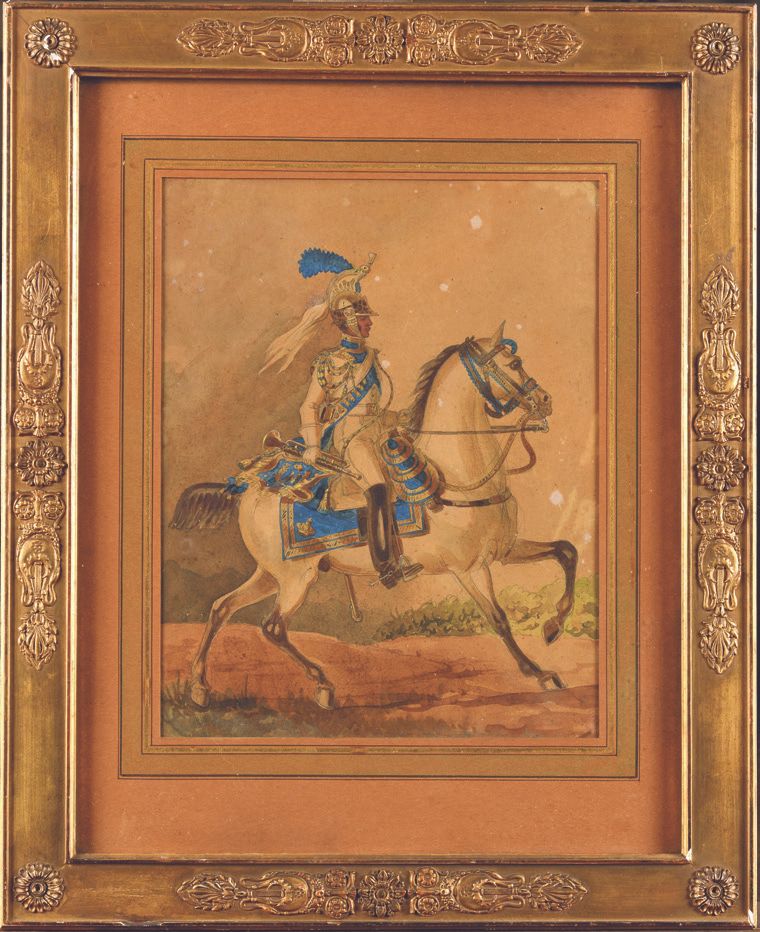Description
FERDINAND-LOUIS JOLLY, KNOWN AS "COLONEL JOLLY". NINETEENTH CENTURY FRENCH SCHOOL. Trumpet of the Imperial Guard Dragoons Pencil, pen and watercolor drawing. 32 x 24 cm. Under glass. Gilt frame. Identified on the back, with label from the Bernard Franck collection. A.B.E. (Insolate) Provenance : Bernard Franck sale, February 22, 1935, no. 91 History: These two watercolors are the work of "Colonel Jolly" as inscribed, probably by Bernard Franck himself on the reverse. In the 19th century, there were two Colonels Jolly, both military, both artists and, to maintain the confusion, both very skilled watercolorists with a rather similar style. Louis-Claude Jolly, "Uncle", was born in Paris in 1775. He joined the Maréchaussée in 1790. He remained in the gendarmerie until 1797, but campaigned in the armies of Sambre et Meuse, Rhin et Moselle. He then joined the 11th Dragoons, where he fought in the German campaign. He left his regiment as a second lieutenant and moved to the Garde des Consuls, the chasseurs à cheval in 1802, at the same rank. In 1805, he was 1st lieutenant of the guard's chasseurs à cheval, and fought in the Austerlitz campaign. When the Imperial Guard Dragoon Regiment was created, he joined it as Adjutant-Major in September 1806, and served in the Polish campaign in 1806-1807, followed by the Austrian campaign in 1809. He was promoted to major in the 29th dragoon regiment, which became the 6th chevau-légers lanciers, and took part in the campaigns of Saxony in 1813 and France in 1814. He was discharged in December 1815, but returned as King's Lieutenant for the Haguenau position in 1818. He was lieutenant-colonel of the Charente chasseurs in 1819, then colonel of the Saône dragons in 1822, and joined them in the Spanish campaign of 1823. This became the 9th cuirassiers in 1825. He retained his command under Louis-Philippe, and died of cholera in Compiègne in 1832. Ferdinand-Louis JOLY "le neveu" was born in Charonne in 1801, the son of Anne-Marguerite Jolly and...an "absent father". He enlisted in the Garonne dragoons, which he left in 1822 as marshal-des-logis to join...the Saône dragoons, his uncle's regiment. He left them in 1833, shortly after his death, as a lieutenant in the 2nd African Chasseurs. He remained there until 1845, serving in virtually all the campaigns of the Algerian conquest. He left Africa in 1846 as squadron leader and joined the 7th Hussars. Finally, in 1850, he was appointed lieutenant-colonel in the 1st chasseur regiment. He fought in Spain in 1823, in Algeria from 1834 to 1946 and finally in Italy (Rome expedition) in 1850. He applied for retirement in 1855. Our two watercolors are clearly in Ferdinand-Louis's style, but have benefited from the excellent sources left by his uncle, and are therefore a first-rate record of these two units, in particular the prestigious dragons of the imperial guard.
126
FERDINAND-LOUIS JOLLY, KNOWN AS "COLONEL JOLLY". NINETEENTH CENTURY FRENCH SCHOOL. Trumpet of the Imperial Guard Dragoons Pencil, pen and watercolor drawing. 32 x 24 cm. Under glass. Gilt frame. Identified on the back, with label from the Bernard Franck collection. A.B.E. (Insolate) Provenance : Bernard Franck sale, February 22, 1935, no. 91 History: These two watercolors are the work of "Colonel Jolly" as inscribed, probably by Bernard Franck himself on the reverse. In the 19th century, there were two Colonels Jolly, both military, both artists and, to maintain the confusion, both very skilled watercolorists with a rather similar style. Louis-Claude Jolly, "Uncle", was born in Paris in 1775. He joined the Maréchaussée in 1790. He remained in the gendarmerie until 1797, but campaigned in the armies of Sambre et Meuse, Rhin et Moselle. He then joined the 11th Dragoons, where he fought in the German campaign. He left his regiment as a second lieutenant and moved to the Garde des Consuls, the chasseurs à cheval in 1802, at the same rank. In 1805, he was 1st lieutenant of the guard's chasseurs à cheval, and fought in the Austerlitz campaign. When the Imperial Guard Dragoon Regiment was created, he joined it as Adjutant-Major in September 1806, and served in the Polish campaign in 1806-1807, followed by the Austrian campaign in 1809. He was promoted to major in the 29th dragoon regiment, which became the 6th chevau-légers lanciers, and took part in the campaigns of Saxony in 1813 and France in 1814. He was discharged in December 1815, but returned as King's Lieutenant for the Haguenau position in 1818. He was lieutenant-colonel of the Charente chasseurs in 1819, then colonel of the Saône dragons in 1822, and joined them in the Spanish campaign of 1823. This became the 9th cuirassiers in 1825. He retained his command under Louis-Philippe, and died of cholera in Compiègne in 1832. Ferdinand-Louis JOLY "le neveu" was born in Charonne in 1801, the son of Anne-Marguerite Jolly and...an "absent father". He enlisted in the Garonne dragoons, which he left in 1822 as marshal-des-logis to join...the Saône dragoons, his uncle's regiment. He left them in 1833, shortly after his death, as a lieutenant in the 2nd African Chasseurs. He remained there until 1845, serving in virtually all the campaigns of the Algerian conquest. He left Africa in 1846 as squadron leader and joined the 7th Hussars. Finally, in 1850, he was appointed lieutenant-colonel in the 1st chasseur regiment. He fought in Spain in 1823, in Algeria from 1834 to 1946 and finally in Italy (Rome expedition) in 1850. He applied for retirement in 1855. Our two watercolors are clearly in Ferdinand-Louis's style, but have benefited from the excellent sources left by his uncle, and are therefore a first-rate record of these two units, in particular the prestigious dragons of the imperial guard.
